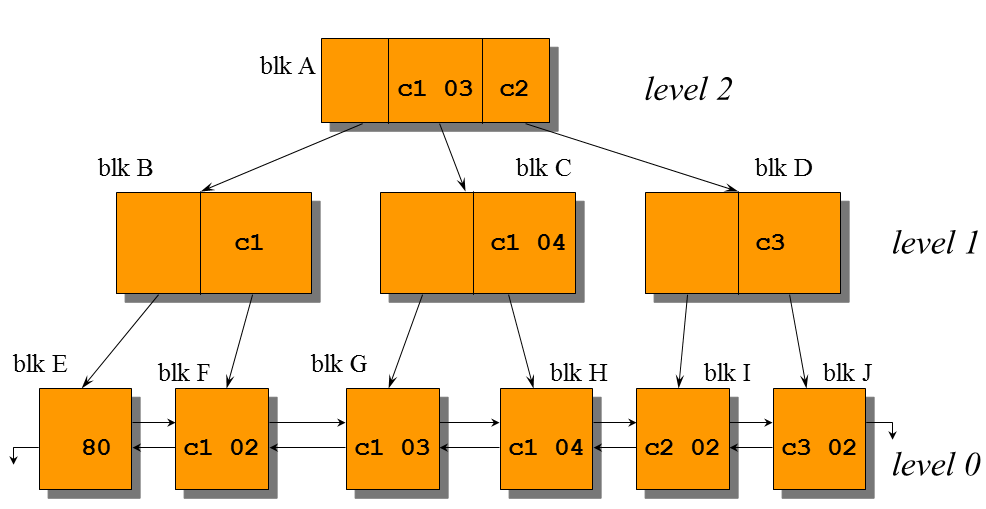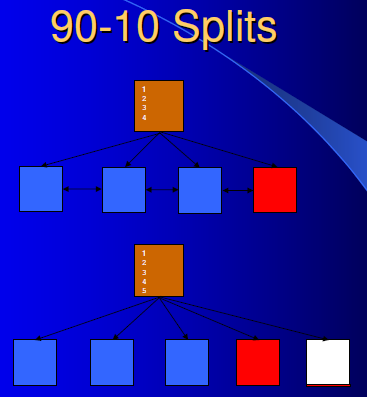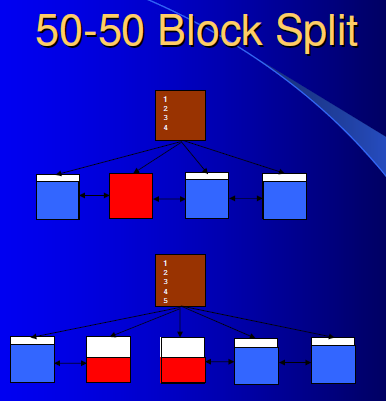
索引块分裂概念介绍
索引中的数据块 按照其作用分为:root block 根块、branch block 枝块、leaf block 叶块。
root block根块:
- 根块是索引的入口
- 对于一个索引而言根块的DBA data block address是固定的
Branch Block:
- 中间的媒介块, root指向branch ,branch指向 leaf
- 数据格式 <Child DBA> <Sseparator>
Leaf Block:
- 最低级别的索引块
- 实际数据存放在leaf blocks中
- 数据格式<Flag> <Lock> <Keydata> <Key> <NonKey>
oracle中的索引块分裂主要分成 以下几种:
- leaf node 90-10 splits
- leaf node 50-50 splits
- branch node splits
- root node splits
索引块分裂index block split 发生在 当某一个 索引块(root branch leaf) 的空闲空间不足以容纳新加入的记录时, 一般来说INSERT是引起索引块分裂的主要操作。
按照 不同的 索引块分类, 其分裂行为可以分为:
- Leaf Block Split
- Branch Block Split
- Root Block Split
按照 leaf Block Split 分裂时的行为 又可以分为:
leaf node 90-10 splits 插入到索引leaf block叶子块中的索引键是该块中最大的键值(包括块中已删除的索引键值)。 在此种情况下实施 90-10 split( 实际是 99-1 ),原叶子块仍保持99%的full, 而到另一个空的叶子块中插入该条新的最大键值记录。如图:
leaf node 90-10 splits 行为的次数可通过v$sysstat视图 中leaf node 90-10 splits获得,AWR中也有对应记录:
leaf node 50-50 splits 当插入到索引叶子块中的索引键值不是该块中的最大值时(包括块中已删除的索引键值), 将发生 50/50 split分裂, 这意味着有一半索引记录仍存在当前块,而另一半数据移动到新的叶子块中。
leaf node 50-50 splits 行为的次数可通过 v$sysstat视图 中的 (leaf node splits)-(leaf node 90-10 splits)获得,AWR中也是类似:
如上图中, 则在该AWR性能报告覆盖的时间中leaf node 50-50 split 发生了(1320-267)=1053 次
Branch Block 50-50 Split 由于不断的索引叶块分裂需要将新的leaf block的信息加入到branch block中,当branch block没有足够空间容纳新的记录时,又会引发branch block的 Split 。 branch block的split 是50-50的,即将一半记录移动到新的branch block中。
Branch Block 50-50 Split 行为的次数可通过 v$sysstat视图 中的branch node splits获得,AWR中也是类似:
Root Block 50-50 Split root block 根块实际是一种特殊的branch block, 当root block 50-50 split分裂发生时将分配2个新的数据块, 分裂将一半的数据移动到一个新块中,另一半数据移动到另一个新块中。 并更新原来的root block,使之指向那2个新的数据块,实际上是2个branch block了。
但是root block的数据块位置本身没有变,仍旧是原来的那个数据块。 当root block split发生时 会导致索引的高度上升。
Root Block 50-50 Split 行为的次数可通过 v$sysstat视图 中的root node splits获得,AWR中也是类似:
索引的高度 height 视乎 索引中记录的多少 、Leaf Block的数量而定,一般Height 为3~4; 举例来说当一个索引的高度为4,但是其中包含大量删除的记录,那么通过索引rebuild 往往可以降低其高度,例如从4降低到3。 假设该索引再次插入了大量的数据,造成leaf block不断分裂,最终导致root block 再次分裂, 索引高度从3再次上升到4,在这个root block split 的过程中可能短期内阻塞索引的DML维护,导致进程等待” enqueue TX: index contention” , 这在OLTP环境中是很常见的问题, 所以一般不推荐在OLTP环境中rebuild index,虽然rebuild index能够减少索引碎片回收空间 ,但由于rebuild index可能导致索引高度降级,所以对于OLTP环境的索引rebuild 需要慎重。
等待事件
当索引块分裂发生时, 负责实施分裂 split 的进程会持有 相关的队列锁enqueue TX 锁, 直到该进程完成Split操作才会释放该enqueue Tx,在这个过程中负责split的进程需要找到合适的新块并将对应的数据移动到该新块中。 若在此split过程中,有其他进程INSERT数据到该索引块中,则将进入 enq: TX – index contention等待事件,直到split结束enqueue TX被释放。
负责split的进程需要找到一个合适的新块, 其会优先寻找本index 已分配的空间中的 free block, 这些free block应当是100% free的,但是在Oracle 的segment bitmap block 中只区分 0%-25%,25%-50%, 50%-75%, 75%-100% 使用率的数据块, 即无法直接区分 0%-25%使用率的数据块中哪些是100% free的数据块, Oracle这样做的目的是 为了重用数据块,以避免过度分配空间。 当oracle发现没有可重用的数据块时才会扩展索引空间并移动分裂数据。
这个在split 过程中 寻找可复用的free block的过程称之为failed probes on index block reclamation,在正常的情况下这种找寻可复用块的过程是很快的 ,但是如果 恰好遇到 物理读缓慢或者 全局的数据块争用时,该过程可能变得很慢,这将直接导致split 变慢, 进而导致大量INSERT进程长时间等待enq: TX – index contention。
RAC中的索引块分裂
在RAC环境中 由于全局缓冲块的争用 以及 全局队列的争用, 在RAC private network 心跳网络传输存在性能瓶颈的情况下可能导致 负责split工作的进程在分裂过程中遇到 例如 gc buffer busy、gc current block busy、gc current split等等待事件,这将极大拖慢 split的速度,导致大量INSERT进程长时间等待enq: TX – index contention。
SQL> select name from v$sysstat where name like '%split%' order by name; NAME ------------------------------------------------------------------------ branch node splits index compression (ADVANCED HIGH) leaf block 90_10 splits faile index compression (ADVANCED HIGH) leaf block splits avoided index compression (ADVANCED LOW) reorg avoid split leaf node 90-10 splits leaf node splits queue splits root node splits
相关Event
10224 “index block split/delete trace”
drop table t1;
create table t1 (name varchar2(2000),nr number) pctfree 0;
create index i1 on t1(name);
alter session set events '10224 trace name context forever,level 1';
declare
i number;
begin
for i in 1..35
loop
insert into t1 values(rpad('Maclean',200,'I'),i);
end loop;
end;
/
insert into t1 values(rpad('9999999',200,'1'),9999);
insert into t1 values(rpad('9999999',200,'1'),9999);
insert into t1 values(rpad('9999999',200,'1'),9999);
oradebug setmypid
oradebug tracefile_name
*** 2013-09-02 12:07:42.632
splitting leaf,dba 0x00419669,time 12:07:42.632
kdisnew first,dba 0x0041966a,time 12:07:42.667
kdisnew using block,dba 0x0041966a,time 12:07:42.667
kdisnew first,dba 0x0041966a,time 12:07:42.667
kdisnew reject block unlink,dba 0x0041966a,time 12:07:42.667
kdisnew loop trying,dba 0x0041966b,time 12:07:42.667
kdisnew using block,dba 0x0041966b,time 12:07:42.667
Reference : <Oracle B-Tree Index Internals: Rebuilding The Truth> Richard Foote







KM SEARCH—————Keyword =index splitting1.How Does the Index Block Splitting Mechanism Work for B*tree Indexes? (Doc ID 183612.1)Block Splitting takes place when a new index key has to be inserted and it does not fit in the index block. Block splitting is done in 2 different ways depending on the inserted value.1 – The inserted key value is not the highest (taking into account values of deleted rows key entries). In this case we do a 50/50 split which means that both the old and the new block are filled 50 percent. 2 – The inserted key value is the highest (taking into account values of deleted rows key entries). In this case, we do a 99/1 split which means that by the end of the split the previous block is 99% full and the new one nearly empty (only the new key value).Method 2 prevents space wastage especially for indexes with only increasing values; for example indexes on timestamps.2.How Btree Indexes Are Maintained (Doc ID 30405.1)The reason for doing this is that, when data is inserted into a Leaf block, andthere is no room for the insert, a very expensive operation called a splitoccurs. The split creates a new Leaf block and possibly new Branch blocks as well to maintain the balance of the tree. The split operation is by far the most expensive operation that is done in the maintenance of B* trees so we go to great lengths to avoid them. By not collapsing the now unused levels out of the B*Trees after large deletes these levels (with splits) do not have to be recreated during future inserts.
find 1. 增加pct_free主要为了防止update带来的空间增长,如果您的系统几乎没有update,那么增加该参数没有意义。 2. 关于您提到的增加cache,是否是指( Doc ID 873243.1 ) 里提到的增加sequence的cache? 如果insert的索引列采用了sequence,那么enq: TX – index contention极有可能因为sequence的cache太小而被dc_sequences的row cache lock阻塞, 这样增加sequence的cache能解决该问题。 请注意增加buffer cache对index split并没有帮助。 针对使用Sequence自增长字段做索引列时,我在互联网查到一些材料,建议使用以下几种方式打散插入索引块的位置,避免索引块热点和减缓索引块频繁分裂的程度。针对我们的业务场景 烦劳您帮忙看看使用场景和注意事项呢? (1)使用反转键索引,索引键值反转以后将键值连续性打散,有效分散索引键值。 适用场景:有效分散索引键值 注意事项:由于连续键值可能分布在不同索引块当中,使用反转键索引进行范围搜索时,查询效率可能会下降。 参考指标:Segments by Row Lock Waits等待事件(2)使用hash 进行索引分区,这样可以使得索引自动进行分散插入不同的分区中适用场景: 注意事项: (3)五五算法模式下,叶子结点保存比较稀疏,占用空间较多。对索引进行alter index coalesce,合并同一个branch的leaf block,并不需要重新排序,所以操作量级更轻,速度更快,影响更小。而rebuild需要重新排序index,而且需要两个index的空间。如果对索引rebuild也会变相压缩索引空间,导致后续的insert同样出现竞争。 适用场景: 注意事项: (4)如果发现某索引经常发生出现”enq: TX – index contention”,增加pct_free参数 适用场景: 注意事项: (5)增加cache大小,必要时增加noorder选项。不同实例开始于不同sequence,减少了同一节点争用。 适用场景:高并发 注意事项:数据库down掉会产生序列号简短 (5)重启应用服务器并终止堵塞会话 适用场景:应急处理 注意事项:无法 (5)应用设计层面调整索引结构,比如在索引列中拼接分行地区号,同样可起到打散索引连续键值,消除索引热点。 适用场景: 注意事项: 方案1:本方案基于您的insert总是顺序的,并且几乎没有select和update 使用反转键索引,使连续键值分布在不同索引块当中,减少enq: TX – index contention争用,并且您很少select,这样并不会给select带来多少性能影响。 并且 如果索引列使用了sqeuence,那么增加sequence的cache大小,必要时增加noorder选项。不同实例开始于不同sequence,减少sequence争用从而避免阻塞enq: TX – index contention。 方案2:根据索引列hash分区,这样能将连续的键值分布在不同分区中,不过您需要修改表定义。 当发生9-1分裂时,通常是索引的键值是递增的,且表上的主要操作为插入操作、事务并发量比较低的情况。 发生5-5分裂时,通常表上的并发事务较多,且插入、删除的数据比较分散。 1. 关于您发现的5-5分裂,5-5分裂一般发生在如下场景: 1)当新插入的数据小于索引中的最大值时,此时数据块空间不足容纳新的键值; 2)当插入、删除数据时,数据块上没有足够空间分配新的ITL slot; 3)当新插入的数据大于或等于索引中最大值时,此时数据块上还存在其它未提交的事务。 4)在RAC模式下,如果Sequence cache很大,会导致在多节点之间Sequence的区段不同,这样区段小的节点发生5-5分裂(原理同1) 2. 关于您列出的5个场景,其实之前我们已经解释过。1,2适合顺序insert,3适合有大量delete/insert/update并发的场景,4无论什么情况都是适用的。 3. 从理论上分析该问题并没有实际作用,我们建议您上传如下信息便于根据您的实际情况做出结论。 1) 所有节点的alert log,主要用于检查是否有一些错误。 2) 问题发生期间1小时的AWR,和正常时候1小时的AWR 3) Dump 问题发生时的ASH 数据。 SQL> conn user/passwd SQL> create table m_ash as select * from dba_hist_active_sess_history where SAMPLE_TIME between TO_TIMESTAMP (”, ‘YYYY-MM-DD HH24:MI:SS’) and TO_TIMESTAMP (”, ‘YYYY-MM-DD HH24:MI:SS’); $ exp user/passwd file=m_ash.dmp tables=(m_ash)